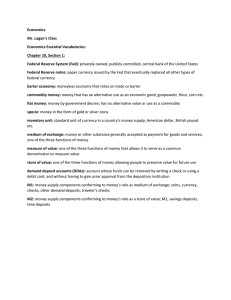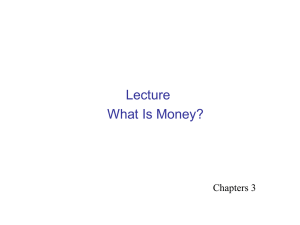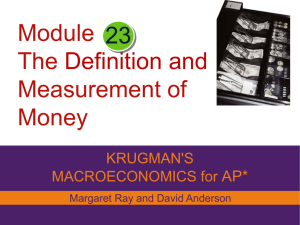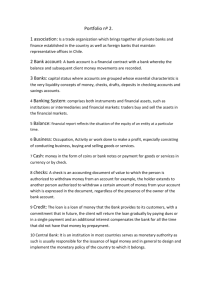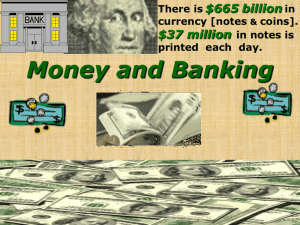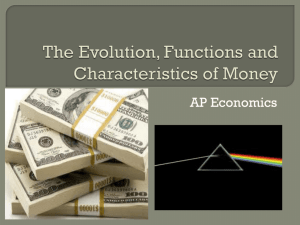Money and Banking
advertisement
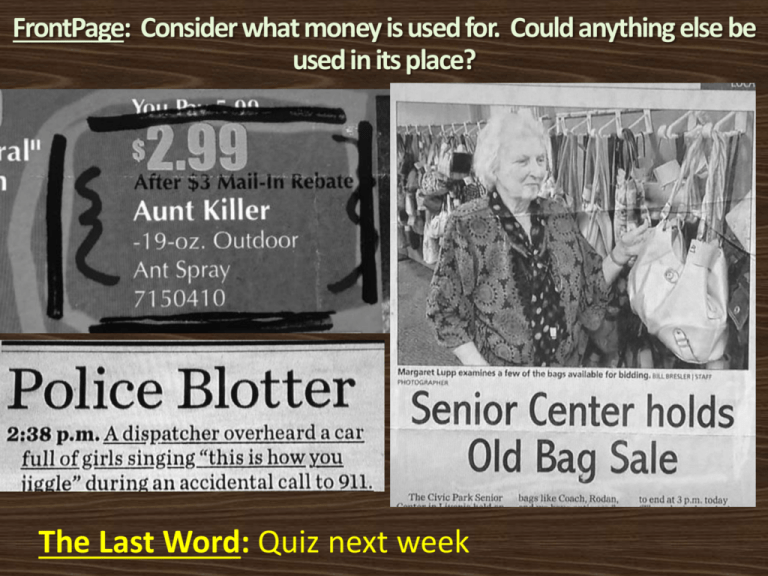
FrontPage: Consider what money is used for. Could anything else be used in its place? The Last Word: Quiz next week https://www.youtube.com/watch?v=F1_OoICS2 b8 Chapter 10, Section 1 Money is anything that people will accept in exchange for goods and services. Money should perform 3 important functions. Function 1: Medium of Exchange Money must serve as a medium of exchange, the means through which goods and services can be exchanged. Without money, economic transactions could only happen through barter – exchanging goods and services for other goods and services have to give them. Barter is inefficient because it requires a double coincidence of wants – someone has what you want and they want what you have to trade. Function 2: Standard of Value Money allows people to measure the relative costs of goods and services. In the U.S., the basic monetary unit is the dollar which is used to state the worth of goods and services in our economy. Function 3: Store of Value Money allows people to store the value of their economic activities. People generally do not have to spend money immediately or only in one place. FrontPage: NNIGN - The more of them you take, the more you leave behind. What are they? A Great Mother’s Day Gift? - What belongs to you but others use it more than you do? - I am the beginning of sorrow, and the end of sickness. You cannot express happiness without me, yet I am in the midst of losses. I am always in risk, yet never in danger. You will find me in sunshine, yet I am also always in darkness. The Last Word: Ch 10 Quiz next week To perform the 3 economic functions of money, an item must possess certain physical and economic properties. - Physical properties are characteristics of the item itself. - Economic properties are linked to the role that money plays in the market. Durability – money should last throughout many transactions, not spoil or fall apart. Portability – money should be small, light, and easy to carry. Divisibility – money should be divisible so that change can be made. Uniformity – money should be uniform, having features and markings that make it commonly recognizable. Stability of value – money’s purchasing power, or value, should remain relatively stable. Scarcity – money must be scarce to have any value. Acceptability – people must be willing to accept it in payment for goods and services. Commodity money derives its value from the type of material from which it is composed. Ex. gold, cattle, rice, etc. Representative money has no intrinsic value, but can be exchanged for something that does. US dollars once were able to be exchanged for an equivalent amount of gold or silver. Fiat money is declared by the govt. and accepted by citizens to have worth (ex. US $ today). Currency is paper money and coins. Checking accounts (and debit cards) are called demand deposits Funds can be converted into currency “on demand.” Can be used “on demand” to purchase things. “Money can't buy love, but it improves your bargaining position.” Near money is savings accounts and time deposits that can be converted into cash relatively easily. It is measured in the same terms as money (ex. $), but is NOT actually money itself. “one step away” from being used as money “A wise person should have money in their head, but not in their heart.” –Jonathan Swift M1 is the narrowest definition of the money supply and includes currency, demand deposits, and other checkable deposits. (2013 – 2.58 Trillion) M2 is a broader measure that includes all of M1 plus savings accounts, certificates of deposits, and money market mutual funds. (2013 – 10.98 Trillion) All US currency remains legal tender, regardless of when it was produced. It costs about $3 on average to produce one note of currency. The law prohibits the changing of the design of the $1 bill. The most counterfeited bill INSIDE the US is the $20 bill. https://uscurrency.gov/security/100-securityfeatures-2013-present How long will “currency” be in circulation? Will we ever be a society without paper money and coins? What could be the problems? Are there advantages? What currency was the highest performing currency in the world in 2015? https://www.youtube.com/watch?annotation_id=annotation_1292109769&feature=iv&src_vid=Um63OQz3bjo&v=Gc2en3nHxA4
